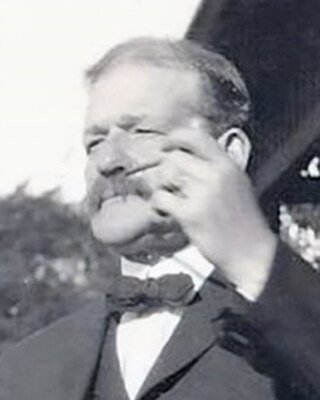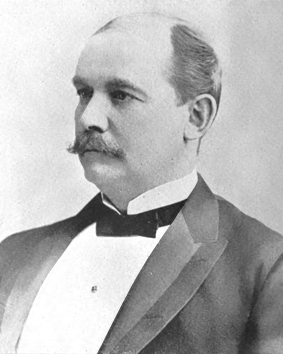
The Park Theatre (est.1879) was a playhouse in Boston, Massachusetts, in the late 19th and early 20th centuries. It later became the State cinema. [1] Located on Washington Street, near Boylston Street, the building existed until 1990.

The Park Theatre (est.1879) was a playhouse in Boston, Massachusetts, in the late 19th and early 20th centuries. It later became the State cinema. [1] Located on Washington Street, near Boylston Street, the building existed until 1990.
In 1879 Henry E. Abbey, proprietor of Abbey's Park Theatre in New York, opened Boston's Park Theatre. [2] Abbey was one half of the theatrical management firm Abbey and Schoeffel, along with his backer John B. Schoeffel. Schoeffel was assistant manager. [3]
It occupied the building of the former Beethoven Hall, "reconstructed and practically rebuilt;" its 1,184-seat auditorium was "60 feet wide, 63 from the state to the doors, and 50 feet high." [4] The architect of the rebuilt theatre was Abel C. Martin. [5] It sat on Washington Street at the corner of Boylston Street in today's Chinatown/Theatre district. [6]
In the 1890s it presented "farcical comedy." [7] Managers and proprietors included Henry E. Abbey; [8] Jack A. Crabtree; [9] [10] Lotta Crabtree; [11] Charles Frohman, Rich & Harris; [12] Lawrence McCarty; [13] John B. Schoeffel (Abbey, Schoeffel and Grau); [8] [9] John Stetson Jr.; [14] and Eugene Tompkins. [13] [14] [15] [16]
Louis Baer led the 11-piece orchestra in the 1890s. [17]
In the 20th century the building became "Minsky's Park Burlesque," the "Hub," "Trans-Lux," [18] [19] and then "The State" cinema. [20] The building survived until its razing in 1990. [21] [22]
1870s–1880s
1890s
| 1900s
1910s
1920s |

"Combat Zone" was the name given in the 1960s to the adult entertainment district in downtown Boston, Massachusetts. Centered on Washington Street between Boylston Street and Kneeland Street, the area was once the site of many strip clubs, peep shows, X-rated movie theaters, and adult bookstores. It had a reputation for crime, including prostitution.

Henry Eugene Abbey was an American theatre manager and producer.

Charlotte Mignon "Lotta" Crabtree, also known mononymously as Lotta, was an American actress, entertainer, comedian, and philanthropist.
Washington Street is a street originating in downtown Boston, Massachusetts, which extends southwestward to the Massachusetts–Rhode Island state line. The majority of its length outside of the city was built as the Norfolk and Bristol Turnpike in the early 19th century. It is the longest street in Boston and remains one of the longest streets in the Commonwealth of Massachusetts. Due to various municipal annexations with the city of Boston, the name Washington Street now exists 6 or more times within the jurisdiction(s) of the City of Boston.

Arthur H. Vinal was an American architect who lived and worked in Boston, Massachusetts. Vinal was born in Quincy, Massachusetts, on July 1, 1855, to Howard Vinal and Clarissa J. Wentworth. Vinal apprenticed at the firm of Peabody & Stearns in Boston before leaving to start his own practice in 1875. Vinal started a partnership with Henry F. Starbuck in 1877; the firm broke up when Starbuck moved away. Vinal served as the second City Architect of Boston from 1884 to 1887. Vinal is principally known for his Richardsonian Romanesque High Service Building at the Chestnut Hill Reservoir (1887). In addition to his other public buildings, Vinal designed numerous residences in Boston and nearby suburbs.
Park Square in downtown Boston, Massachusetts is bounded by Stuart, Charles Street South, Boylston, and Arlington Streets. It is the home of the Boston Four Seasons Hotel, the Boston Park Plaza, and nearly a dozen restaurants. To the north across Boylston Street is the Boston Public Garden. To the east is the Washington Street Theatre District. The Bay Village neighborhood is to the south, and Back Bay is to the west.
The Boston Theatre was a theatre in Boston, Massachusetts. It was first built in 1854 and operated as a theatre until 1925. Productions included performances by Thurlow Bergen, Charles A. Bigelow, Edwin Booth, Anna Held, James O'Neill Jennie Kimball, and others.
Beethoven Hall (1874–78) was an auditorium in Boston, Massachusetts, that hosted musical performances and other entertainments in the 1870s. It sat on Washington Street, near Boylston Street, in today's Boston Theater District/Chinatown neighborhood. The architect was William Washburn, who had also designed the first National Theatre and the second Tremont Temple.

The Columbia Theatre or Loew's New Columbia Theatre in Boston, Massachusetts, was a playhouse and cinema located in the South End at No. 978 Washington Street. Charles Frohman, Isaac Baker Rich and William Harris oversaw the theatre until 1895. Owners included J.J. Grace of New York and Loews. Staff included Harry Farren, Saul Hamilburg and Philip Shea. The Columbia existed until its demolition in 1957.

The Tremont Theatre was a playhouse in Boston, Massachusetts, in the late 19th and early 20th centuries. Henry E. Abbey and John B. Schoeffel established the enterprise and oversaw construction of its building at no.176 Tremont Street in the Boston Theater District area. Managers included Abbey, Schoeffel and Grau, Klaw & Erlanger, Thos. B. Lothan and Albert M. Sheehan.

Selwyn's Theatre (1867–1870) of Boston, Massachusetts, was established by British-born actor John H. Selwyn. Architect Benjamin F. Dwight designed the building. Personnel included Dexter H. Follet, Arthur Cheney, H.A. M'Glenen, Charles R. Thorne Jr., and Charles Koppitz. In 1871 Selwyn's was renamed the "Globe Theatre."
The Plymouth Theatre (1911–1957) of Boston, Massachusetts, was located on Stuart Street in today's Boston Theater District. Architect Clarence Blackall designed the building for Liebler & Co. Performers included Henry Jewett, Bill "Bojangles" Robinson, 8-year-old Sammy Davis, Jr., and Bette Davis. In October 1911, the touring Abbey Theatre presented Synge's Playboy of the Western World at the Plymouth; in the audience were W. B. Yeats, Isabella Stewart Gardner and Rose Fitzgerald Kennedy.
The Palace Theatre (ca.1891-1931) of Boston, Massachusetts was a variety theatre on Court Street in the late 19th and early 20th centuries. Acts which performed there included Rose Hill Folly Co., Clifford & Dixon, Murry & Murry, Behler & Stone, and the Adamless Eden Burlesquers. It also showed photo-plays such as The Exploits of Elaine, The Master Key, and "Charles Chaplin comedies." Among its managers and proprietors were William Austin, F. J. Pilling, George Milbank, and Dunn & Waldron. The Palace occupied the building of the former Nickelodeon. It existed until 1931, when it was demolished.
The RKO Boston Theatre was a movie theatre in Boston, Massachusetts, located at 616 Washington Street, near Essex Street in the Boston Theater District. It opened as the Keith-Albee Boston Theatre on October 5, 1925.

The Fenway Theatre (1915–1972) of Boston, Massachusetts, was a cinema and concert hall in the Back Bay, located at no.136 Massachusetts Avenue at Boylston Street.
The Gaiety Theatre (1908–1949) or Gayety Theatre of Boston, Massachusetts, was located at no.661 Washington Street near Boylston Street in today's Boston Theater District. It featured burlesque, vaudeville and cinema. Performers included Clark and McCullough, Solly Ward, and Lena Daley; producers included Charles H. Waldron, Earl Carroll, and E.M. Loew. In 1949 it became the "Publix Theatre." The building existed until its razing in 2005.
Hotel Touraine (1897-1966) in Boston, Massachusetts, was a residential hotel on the corner of Tremont Street and Boylston Street, near the Boston Common. The architecture firm of Winslow and Wetherell designed the 11-story building in the Jacobethan style, constructed of "brick and limestone;" its "baronial" appearance was "patterned inside and out after a 16th-century chateau of the dukes of Touraine." It had dining rooms and a circulating library. Owners included Joseph Reed Whipple and George A. Turain.

Abbey, Schoeffel and Grau was a US theatre management and production firm, active from 1880 until 1896. The partners were Henry E. Abbey, John B. Schoeffel and Maurice Grau. Abbey and Schoeffel had been in partnership since 1876, and joined forces with Grau in 1882. They managed and ran a number of theatres in New York and Boston, including the Metropolitan Opera House in 1883-4 and from 1891 to 1896, when Abbey died. Schoeffel and Grau remained at the Met until 1903.

John Baptist Schoeffel, was an American theatre manager and producer, and hotel owner. With Henry E. Abbey he was involved presenting European theatrical stars in the US, including Sarah Bernhardt, Henry Irving and Ellen Terry: and with Maurice Grau he and Abbey managed opera singers as Adelina Patti, Christina Nilsson, Ernestine Schumann-Heink, Francesco Tamagno and Fyodor Chaliapin in their tours of opera houses in Boston, Chicago and New York.
Abbey's Park Theatre or Abbey's New Park Theatre was a playhouse at 932 Broadway and 22nd Street in what is now the Flatiron District of Manhattan in New York City. It opened as the New Park Theatre in 1874, and was in use until 1882 when it burned down and was never rebuilt as a theatre.